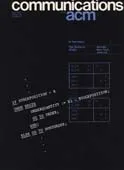May 1973 - Vol. 16 No. 5

Features
On the problem of communicating complex information
The nature of the difficulty involved in communicating mathematical results between scientists using a computer based information retrieval system is examined. The problem is analyzed in terms of psychological and information-processing processes, and what turns out to be a vicious circle of effects is described. The paper then considers how the presentation of information by a computer-based information retrieval system, or by other media, can be improved. Some trade-offs which affect the design of the presentation are mentioned, and a number of ideas for improvement are described. These include ways of augmenting written natural language by various notational and linguistic devices, the exhibition of the structure inherent in the information we are communicating, and a sophisticated interactive system controlled by computer.
Programming by questionnaire: an effective way to use decision tables
Programming by questionnaire combines aspects of decision table programming and general purpose programming by using decision tables to construct an application program through the selection of certain source statements from a predefined file. It is proposed that programming by questionnaire is a useful compromise between general and special purpose programming for a significant class of large scale problems. The elements of the approach are discussed and an existing application is described.
Some comments on the use of ambiguous decision tables and their conversion to computer programs
This paper comments upon recently published work on decision table translation using methods similar to the rule-mask technique. The applicability of these methods under various possible conventions on overall table meaning is discussed, and it is argued that there is a place both for the multi-rule and the single-rule (or action set) convention in decision table usage.
Hierarchical storage in information retrieval
A probabilistic analysis is employed to determine the effect of hierarchical storage organizations on information retrieval operations. The data storage hardware is assumed to consist of n-levels of linearly connected memory hardware with increasing data access times and increasing data storage capabilities. A system might, for example, consist of fast semiconductor memory, computer core memory, extended core storage, disk memory, and data cells. Equations are derived to predict the effect of such a system on data access times using sequential files, random access files, and structured files employing multiple-hierarchical linked lists.
Minimal event-node network of project precedence relations
A procedure for constructing a minimal event-node network to represent a set of precedence relations without parallel activities is presented. A minimal event-node network is an event-node network in which both the number of nodes and the number of arcs are the minima to preserve the given precedence relations. Counterexamples are given to show that the algorithm presented by A.C. Fisher, J.S. Liebman, and G.L. Nemhauser (1968) produces event-node networks which are not minimal. Since our procedure includes the set-covering problem, the time required may grow exponentially with the number of given activities.
An array grammar programming system
A package of Fortran programs has been developed that permits a user to interactively design and test array grammars. The user can control the rule selection procedure in a derivation or parse, using weighted programming matrices; he also has a choice of instance selection schemes (raster, random, parallel). Examples are given involving array languages consisting of simple geometrical patterns, as well as a language of “neuron pictures.”
A nonrecursive list moving algorithm
An efficient, nonrecursive algorithm is given for moving any LISP-type list. In particular, the algorithm requires no storage other than the new nodes into which the lists is to be moved, and no additional bits per node for marking; the algorithm runs in time proportional to the number of nodes in the list. The original list structure is destroyed as it is moved.
Remark 2 on algorithm 300 [S22]
The procedure Coulomb can be used very well to generate the Coulomb wave functions FL and GL and their derivatives, needed in elastic scattering calculations in nuclear physics. When the procedure is used many times for many values of rho and eta, it is not only very useful but also necessary to have in each instance an indication about the accuracy of the results. It is obvious to use the Wronskian relations FL′GL - FLGL′ ≡ 1 for the purpose of checking the results, as Fröberg [1] states after formula (3.4). However, one has to be very careful in using these relations. The most significant check is given later on, but first it is shown what can go wrong.
WYLBUR: an interactive text editing and remote job entry system
WYLBUR is a comprehensive system for manipulating all kinds of text, such as computer programs, letters, and manuscripts, using typewriter terminals connected to a computer. It has facilities for remote job entry and retrieval as well as facilities for text alignment and justification. A powerful method for addressing text by content is provided. This paper describes the external appearance of WYLBUR as well as its internal structure. A short description of the major features of ORVYL, a general purpose time-sharing system which operates in conjunction with WYLBUR, is also included.
A practical approach to managing resources and avoiding deadlocks
Resource scheduling and allocation can be expensive with regard to time and space in multiprogramming or time-sharing environments involving large numbers of tasks and resources with conflicting requirements. Detection and/or prevention of deadlocks can require massive amounts of additional overhead if efficient usage of resources is to be maintained.
A resource management program is described which uses linked lists along with other techniques to overcome a large portion of this overhead. The program, which is currently running as part of a large scale general purpose operating system, keeps resources relatively active but does not detect or prevent all deadlocks in its implemented state. Certain changes, which would permit more comprehensive levels of deadlock prevention/detection at additional cost, have not been incorporated in the running system due to the infrequency of deadlock situations.



